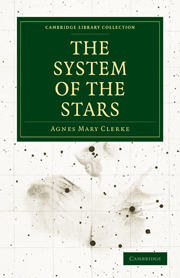Book contents
- Frontmatter
- PREFACE
- Contents
- ILLUSTRATIONS
- ADDENDA
- CHAPTER I THE TASK OF SIDEREAL ASTRONOMY
- CHAPTER II THE METHODS OF SIDEREAL RESEARCH
- CHAPTER III SIRIAN AND SOLAR STARS
- CHAPTER IV STARS WITH BANDED SPECTRA
- CHAPTER V GASEOUS STARS AND NEBULÆ
- CHAPTER VI SIDEREAL EVOLUTION
- CHAPTER VII TEMPORARY STARS
- CHAPTER VIII VARIABLE STARS OF LONG PERIOD
- CHAPTER IX VARIABLE STARS OF SHORT PERIOD
- CHAPTER X THE COLOURS OF THE STARS
- CHAPTER XI DOUBLE STARS
- CHAPTER XII VARIABLE DOUBLE STARS
- CHAPTER XIII STELLAR ORBITS
- CHAPTER XIV MULTIPLE STARS
- CHAPTER XV THE PLEIADES
- CHAPTER XVI STAR CLUSTERS
- CHAPTER XVII THE FORMS OF NEBULÆ
- CHAPTER XVIII THE GREAT NEBULÆ
- CHAPTER XIX THE NATURE AND CHANGES OF NEBULÆ
- CHAPTER XX THE DISTANCES OF THE STARS
- CHAPTER XXI TRANSLATION OF THE SOLAR SYSTEM
- CHAPTER XXII THE PROPER MOTIONS OF THE STARS
- CHAPTER XXIII THE MILKY WAY
- CHAPTER XXIV STATUS OF THE NEBULÆ
- CHAPTER XXV THE CONSTRUCTION OF THE HEAVENS
- APPENDIX.—TABLES OF STELLAR DATA
- INDEX
- Plate section
CHAPTER XVII - THE FORMS OF NEBULÆ
Published online by Cambridge University Press: 05 July 2011
- Frontmatter
- PREFACE
- Contents
- ILLUSTRATIONS
- ADDENDA
- CHAPTER I THE TASK OF SIDEREAL ASTRONOMY
- CHAPTER II THE METHODS OF SIDEREAL RESEARCH
- CHAPTER III SIRIAN AND SOLAR STARS
- CHAPTER IV STARS WITH BANDED SPECTRA
- CHAPTER V GASEOUS STARS AND NEBULÆ
- CHAPTER VI SIDEREAL EVOLUTION
- CHAPTER VII TEMPORARY STARS
- CHAPTER VIII VARIABLE STARS OF LONG PERIOD
- CHAPTER IX VARIABLE STARS OF SHORT PERIOD
- CHAPTER X THE COLOURS OF THE STARS
- CHAPTER XI DOUBLE STARS
- CHAPTER XII VARIABLE DOUBLE STARS
- CHAPTER XIII STELLAR ORBITS
- CHAPTER XIV MULTIPLE STARS
- CHAPTER XV THE PLEIADES
- CHAPTER XVI STAR CLUSTERS
- CHAPTER XVII THE FORMS OF NEBULÆ
- CHAPTER XVIII THE GREAT NEBULÆ
- CHAPTER XIX THE NATURE AND CHANGES OF NEBULÆ
- CHAPTER XX THE DISTANCES OF THE STARS
- CHAPTER XXI TRANSLATION OF THE SOLAR SYSTEM
- CHAPTER XXII THE PROPER MOTIONS OF THE STARS
- CHAPTER XXIII THE MILKY WAY
- CHAPTER XXIV STATUS OF THE NEBULÆ
- CHAPTER XXV THE CONSTRUCTION OF THE HEAVENS
- APPENDIX.—TABLES OF STELLAR DATA
- INDEX
- Plate section
Summary
The fantastic variety of nebular forms was long a subject of wonder, scarcely tempered by a speculative effort. Inchoate worlds, disclosed with astonishing profusion by Herschel's telescopes, seemed like mere ‘sports of nature’ in the sidereal spaces. Nebulæ were to be found in the semblance of rings, fans, brushes, spindles; they abounded in planetary, cometary, elliptical, branching varieties; nebulous shields, embossed with stars, or tasselled like the ægis of Athene, displayed themselves, as well as nebulous dises, rays, filaments, triangles, parallelograms, twin and triple spheres. One nebula, thought to resemble the face of an owl, was named accordingly; another suggested a crab; a third a swan; a fourth (the great Orion formation) became known as the Fish Mouth nebula, from its supposed likeness to the gaping jaws of a marine monster. Fancy ranged at large through this wide realm, attempting to familiarise itself with the strange objects contained in it by finding for them terrestrial similitudes.
Within the last few years, however—indeed, it may be said, since the completion of the Rosse reflector in 1845—nebular inquiries have entered upon a new phase. A ‘glimmering of reason’ has begun to hover over what long appeared a scene of hopeless bewilderment. With improved telescopic means—above all, with the aid of photography—structure has become increasingly manifest among all classes of nebulæ; structure, not of a finished kind, but indicating with great probability the advance of formative processes on an enormous scale, both as regards space and time.
- Type
- Chapter
- Information
- The System of the Stars , pp. 251 - 267Publisher: Cambridge University PressPrint publication year: 2010First published in: 1890



